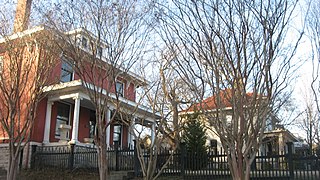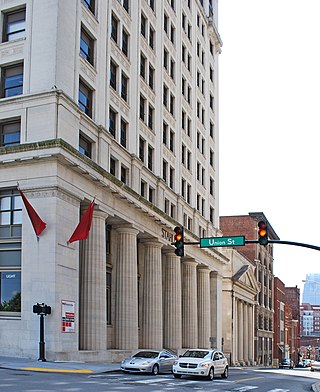
Nashville is the capital and most populous city of the U.S. state of Tennessee, and the seat of Davidson County. With a population of 689,447 at the 2020 U.S. census, Nashville is the 21st most-populous city in the United States, and the fourth most populous city in the southeastern U.S. Located on the Cumberland River, the city is the center of the Nashville metropolitan area, and is one of the fastest growing in the nation.

Fisk University is a private historically black liberal arts college in Nashville, Tennessee. It was founded in 1866 and its 40-acre (16 ha) campus is a historic district listed on the National Register of Historic Places.

Music Row is a historic district located southwest of downtown Nashville, Tennessee, United States. Widely considered the heart of Nashville's entertainment industry, Music Row has also become a metonymous nickname for the music industry as a whole, particularly in country music, gospel music, and contemporary Christian music.

The Tennessee State Capitol, located in Nashville, Tennessee, is the seat of government for the U.S. state of Tennessee. It serves as the home of both houses of the Tennessee General Assembly–the Tennessee House of Representatives and the Tennessee Senate–and also contains the governor's office. Designed by architect William Strickland (1788–1854) of Philadelphia and Nashville, it was built between 1845 and 1859 and is one of Nashville's most prominent examples of Greek Revival architecture. The building, one of 12 state capitols that does not have a dome, was added to the National Register of Historic Places in 1970 and named a National Historic Landmark in 1971. The tomb of James K. Polk, the 11th president of the United States, is on the capitol grounds.

The Greensboro sit-ins were a series of nonviolent protests in February to July 1960, primarily in the Woolworth store—now the International Civil Rights Center and Museum—in Greensboro, North Carolina, which led to the F. W. Woolworth Company department store chain removing its policy of racial segregation in the Southern United States. While not the first sit-in of the civil rights movement, the Greensboro sit-ins were an instrumental action, and also the best-known sit-ins of the civil rights movement. They are considered a catalyst to the subsequent sit-in movement, in which 70,000 people participated. This sit-in was a contributing factor in the formation of the Student Nonviolent Coordinating Committee (SNCC).

The Nashville sit-ins, which lasted from February 13 to May 10, 1960, were part of a protest to end racial segregation at lunch counters in downtown Nashville, Tennessee. The sit-in campaign, coordinated by the Nashville Student Movement and the Nashville Christian Leadership Council, was notable for its early success and its emphasis on disciplined nonviolence. It was part of a broader sit-in movement that spread across the southern United States in the wake of the Greensboro sit-ins in North Carolina.

The International Civil Rights Center & Museum (ICRCM) is located in Greensboro, North Carolina, United States. Its building formerly housed the Woolworth's, the site of a nonviolent protest in the civil rights movement. Four students from North Carolina Agricultural and Technical State University started the Greensboro sit-ins at a "whites only" lunch counter on February 1, 1960. The four students were Franklin McCain, Joseph McNeil, Ezell Blair Jr., and David Richmond. The next day there were twenty students. The aim of the museum's founders is to ensure that history remembers the actions of the A&T Four, those who joined them in the daily Woolworth's sit-ins, and others around the country who took part in sit-ins and in the civil rights movement. The Museum is currently supported by earned admissions and Museum Store revenues. The project also receives donations from private donors as a means of continuing its operations. The museum was founded in 1993 and officially opened its doors fifty years to the day after the sit-in movements in Greensboro NC.
This is a list of the National Register of Historic Places listings in Davidson County, Tennessee.
The following is a timeline of the history of the city of Nashville, Tennessee, United States.
Church Street is a major thoroughfare in Nashville, Tennessee. It is home to several skyscrapers and buildings listed on the National Register of Historic Places.

The Second Avenue Commercial District is a historic district in Nashville, Tennessee, consisting of Second Avenue North between Brandon Street and Broadway. It was listed on the National Register of Historic Places on February 2, 1972.

The Broadway Historic District or Honky Tonk Highway is a historic district located in Nashville, Tennessee. It was listed on the National Register of Historic Places listings in Davidson County, Tennessee (NRHP) in 1980.

Whites Creek Historic District is a historic neighborhood in Whites Creek, Tennessee. It was listed on the National Register of Historic Places listings in Davidson County, Tennessee (NRHP) in 1984.

Belmont–Hillsboro Historic District is a historic neighborhood in Nashville, Tennessee. It was listed on the National Register of Historic Places listings in Davidson County, Tennessee (NRHP) in 1980. The area homes are now protected by a Belmont-Hillsboro Neighborhood Conservation Zone which creates rules for homeowners within the district.

The Old Hickory Post Office is a historic neighborhood post office in the Old Hickory neighborhood of Nashville, Tennessee. It was listed on the National Register of Historic Places listings in Davidson County, Tennessee (NRHP) in 1985.

Buena Vista Historic District is a historic neighborhood in Nashville, Tennessee. It was listed on the National Register of Historic Places listings in Davidson County, Tennessee (NRHP) in 1980.

East Nashville Historic District is a historic neighborhood in East Nashville, Tennessee. It was listed on the National Register of Historic Places listings in Davidson County, Tennessee (NRHP) in 1982.

Buena Vista Historic District is a historic neighborhood in East Nashville, Tennessee. It was listed on the National Register of Historic Places listings in Davidson County, Tennessee (NRHP) in 1979.

The Nashville Financial Historic District or Wall Street of the South is a historic district in downtown Nashville, Tennessee. It was listed on the National Register of Historic Places listings in Davidson County, Tennessee (NRHP) in 2002.

Eighth Avenue South Reservoir is a man-made masonry reservoir in Nashville, Tennessee. The reservoir was built on Kirkpatrick's Hill which was the former site of Fort Casino: a Union Army fort in the American Civil War. Completed in 1889, it ruptured in 1912 causing much property damage, and was repaired in 1914. In 1978, it was listed on the National Register of Historic Places listings in Davidson County, Tennessee (NRHP). The reservoir is the largest and oldest working reservoir supplying water to the city of Nashville, and remains in use as of 2022.




















